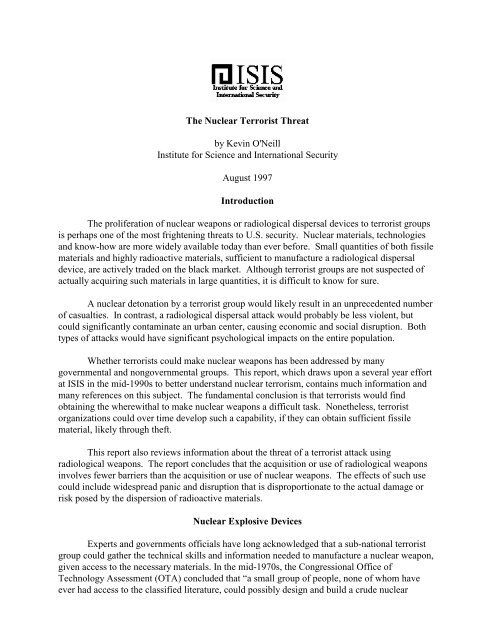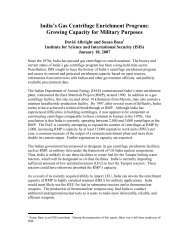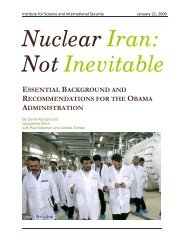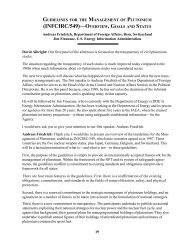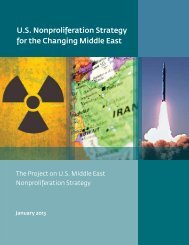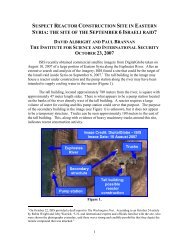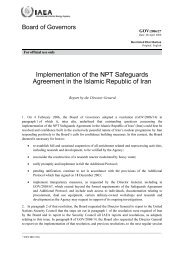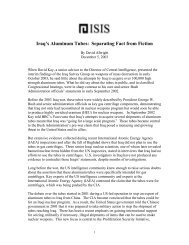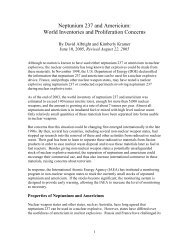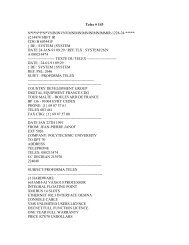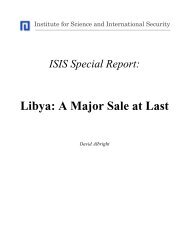The Nuclear Terrorist Threat - Institute for Science and International ...
The Nuclear Terrorist Threat - Institute for Science and International ...
The Nuclear Terrorist Threat - Institute for Science and International ...
You also want an ePaper? Increase the reach of your titles
YUMPU automatically turns print PDFs into web optimized ePapers that Google loves.
<strong>The</strong> <strong>Nuclear</strong> <strong>Terrorist</strong> <strong>Threat</strong>by Kevin O'Neill<strong>Institute</strong> <strong>for</strong> <strong>Science</strong> <strong>and</strong> <strong>International</strong> SecurityAugust 1997Introduction<strong>The</strong> proliferation of nuclear weapons or radiological dispersal devices to terrorist groupsis perhaps one of the most frightening threats to U.S. security. <strong>Nuclear</strong> materials, technologies<strong>and</strong> know-how are more widely available today than ever be<strong>for</strong>e. Small quantities of both fissilematerials <strong>and</strong> highly radioactive materials, sufficient to manufacture a radiological dispersaldevice, are actively traded on the black market. Although terrorist groups are not suspected ofactually acquiring such materials in large quantities, it is difficult to know <strong>for</strong> sure.A nuclear detonation by a terrorist group would likely result in an unprecedented numberof casualties. In contrast, a radiological dispersal attack would probably be less violent, butcould significantly contaminate an urban center, causing economic <strong>and</strong> social disruption. Bothtypes of attacks would have significant psychological impacts on the entire population.Whether terrorists could make nuclear weapons has been addressed by manygovernmental <strong>and</strong> nongovernmental groups. This report, which draws upon a several year ef<strong>for</strong>tat ISIS in the mid-1990s to better underst<strong>and</strong> nuclear terrorism, contains much in<strong>for</strong>mation <strong>and</strong>many references on this subject. <strong>The</strong> fundamental conclusion is that terrorists would findobtaining the wherewithal to make nuclear weapons a difficult task. Nonetheless, terroristorganizations could over time develop such a capability, if they can obtain sufficient fissilematerial, likely through theft.This report also reviews in<strong>for</strong>mation about the threat of a terrorist attack usingradiological weapons. <strong>The</strong> report concludes that the acquisition or use of radiological weaponsinvolves fewer barriers than the acquisition or use of nuclear weapons. <strong>The</strong> effects of such usecould include widespread panic <strong>and</strong> disruption that is disproportionate to the actual damage orrisk posed by the dispersion of radioactive materials.<strong>Nuclear</strong> Explosive DevicesExperts <strong>and</strong> governments officials have long acknowledged that a sub-national terroristgroup could gather the technical skills <strong>and</strong> in<strong>for</strong>mation needed to manufacture a nuclear weapon,given access to the necessary materials. In the mid-1970s, the Congressional Office ofTechnology Assessment (OTA) concluded that “a small group of people, none of whom haveever had access to the classified literature, could possibly design <strong>and</strong> build a crude nuclear
device.” 1 In the mid-1980s, J. Carson Mark, <strong>The</strong>odore Taylor <strong>and</strong> other <strong>for</strong>mer nuclear weaponsdesigners estimated that the “the number of specialists required [to build a crude nuclear weapon]would depend upon the background of those enlisted, but their number could scarcely be fewerthan three of four <strong>and</strong> might as well have to be more.” 2 In<strong>for</strong>mation about the Iraqi <strong>and</strong> SouthAfrican nuclear weapons programs suggests that considerably more individuals are needed todesign <strong>and</strong> assemble a reliable nuclear weapon that is deliverable as a gravity bomb or missilewarhead. However, the estimate by Mark, Taylor et. al. serves as a lower bound of what isneeded to assemble a far less sophisticated <strong>and</strong> reliable device that those pursued by these orother countries. In contrast, Mark <strong>and</strong> Taylor suggest, a crude terrorist device would likely weigha tonne or more, have a nominal yield in the range of tens of kilotons, <strong>and</strong> be delivered by atruck, airplane or a ship. 3In order to manufacture a crude nuclear weapon, a terrorist organization needs to possessspecialized expertise in areas such as high explosives, propellants, electronics, nuclear physics,chemistry <strong>and</strong> engineering. Knowledge of the physical <strong>and</strong> chemical properties of plutonium orhighly enriched uranium (HEU) is essential. <strong>The</strong> terrorist group also must obtain detailed designdrawings of weapons components <strong>and</strong> of the final assembled device.In the past, such in<strong>for</strong>mation was difficult to come by in the open literature. Today,according to Defense Department <strong>and</strong> Energy Department officials, important <strong>and</strong> usefulin<strong>for</strong>mation about the design <strong>and</strong> assembly of nuclear weapons or weapons components can befound on internet sites <strong>and</strong> World Wide Web pages. Unlike other resources, the internetprovides a com<strong>for</strong>table anonymity to those posting or seeking sensitive in<strong>for</strong>mation. Egocentricindividuals can post in<strong>for</strong>mation anonymously or under pseudonyms <strong>and</strong> com<strong>for</strong>tably brag abouttheir technical prowess. Serious browsers can w<strong>and</strong>er through huge technical databases withoutthe unpleasant task of confronting a human librarian. Given this anonymity, the internet canfunction as an instantaneous, global clearinghouse of in<strong>for</strong>mation <strong>and</strong> provide a useful firstsource <strong>for</strong> terrorist groups, which otherwise would have to search the public literature in moreconspicuous ways. Indeed, perhaps the best defense against in<strong>for</strong>mation transferred over theinternet is the sheer size of the internet itself <strong>and</strong> the large quantity of erroneous, incomplete ormisleading in<strong>for</strong>mation that is being posted.<strong>Terrorist</strong>s bent on assembling a nuclear explosive must acquire sufficient quantities ofplutonium or HEU that is in a weapons-usable <strong>for</strong>m. Depending on the quantity <strong>and</strong> <strong>for</strong>m ofmaterial that it initially acquires, a subnational terrorist group may need to convert fissilematerials from one <strong>for</strong>m to another, requiring expertise in chemistry <strong>and</strong> access to necessarychemicals <strong>and</strong> equipment. Much of the world's less-protected stocks of fissile material cannot beused directly in nuclear weapons. By one recent estimate, over 700 tonnes of plutonium iscontained in highly radioactive spent nuclear reactor fuel that has been discharged fromcommercial nuclear power reactors. 4 Be<strong>for</strong>e this plutonium could be used in nuclear weapons, itwould have to be separated from the remaining uranium, cladding <strong>and</strong> fission products in alaboratory or reprocessing facility. It is highly unlikely that a subnational terrorist group wouldbe able to gain access to such facilities or carry out such activities without being detected.2
Table 1Forms of Fissile Material <strong>and</strong> Associated Activity to Convert Materials to a Weapons-Usable FormForm (separated<strong>Nuclear</strong> Weapon Activityfrom spent fuel)Weapon DesignConversion toMetal*Foundry <strong>and</strong>MachiningPure Metal Yes No yesOxide Yes yes yesScrap or Residue Yes yes yesIntermediate Forms Yes yes yes* includes dissolution, purification, precipitation, calcination <strong>and</strong> metal reductionOther less-protected materials pose a greater risk of diversion, but would still requirepurification <strong>and</strong> chemical processing to make them usable <strong>for</strong> nuclear weapons (see table 1). <strong>The</strong>manufacture of tens of thous<strong>and</strong>s of nuclear weapons by the United States, Russia, Great Britain,France <strong>and</strong> China has generated large quantities of scraps, residues <strong>and</strong> other <strong>for</strong>ms containingplutonium <strong>and</strong> HEU. For example, declared plutonium inventories at the Rocky Flats Plant,where the U.S. manufactured plutonium pits <strong>for</strong> nuclear weapons, include 6.6 tonnes of metal,3.2 tonnes of oxide <strong>and</strong> 2.9 tonnes of scraps <strong>and</strong> residue, <strong>and</strong> 98 kilograms of plutonium insolution (see table 2). 5 Additional quantities of plutonium or HEU are also contained in waste,which were shipped off site <strong>and</strong> are even less well characterized <strong>and</strong> protected.Table 2Plutonium Forms at Rocky FlatsFormQuantity(kg)Typical FormsMetal 6,600 pits, buttons ingots, metal scrapOxides 3,200 Casting skulls, peroxide cake, non-specific <strong>for</strong>msScrap <strong>and</strong> Residues 2,900 pyrochemical salts, filters, graphites/carbides, impure oxide,fluorides, wet combustibles, dissolver heels, s<strong>and</strong>, slag <strong>and</strong> cruciblescraps, glass, chloridesSolutions 98 Acidic nitrates <strong>and</strong> chlorides3
Many of the chemicals <strong>and</strong> equipment needed to convert all but the most highly irradiated<strong>for</strong>ms of plutonium or HEU can be purchased commercially. But the conversion of materialfrom one <strong>for</strong>m to another adds complications <strong>and</strong> time to the terrorist group’s ef<strong>for</strong>ts to obtainnuclear weapons, which increases the risk of detection by the authorities. Unlike a country thatproduces its own fissile materials, a terrorist group is constrained by its ability to obtain whatevertype of material it can find.<strong>The</strong> breakup of the Soviet Union has made nuclear weapons, materials <strong>and</strong> technologiesmore accessible to proliferant nations <strong>and</strong> terrorist groups, alike. In March 1996, Director ofCentral Intelligence John Deutch warned that the Soviet collapse has brought about “the chillingreality ... that nuclear materials <strong>and</strong> technologies are more accessible now than at any other timein history.” 6 According to U.S. intelligence, the deteriorating economic situation, low pay <strong>and</strong>poor morale among Russian military personnel “could undermine the [nuclear weapons]stockpile's security, making theft of warheads or subcomponents possible.” 7While the quantities of fissile materials that may be vulnerable to theft are measured intonnes, the amount of such materials that a terrorist group would need to assemble a nuclearexplosive device is measured in tens of kilograms. Former U.S. nuclear weapons designersCarson Mark <strong>and</strong> <strong>The</strong>odore Taylor note that terrorists would require “something like a criticalmass” of fissile material <strong>for</strong> an implosion device. 8 Bare, unreflected critical masses are given intable 3 <strong>for</strong> comparison purposes.Table 3 -- Bare-sphere critical masses of uranium- 235, plutonium, <strong>and</strong> other fissionable materialsMaterialBare critical sphereUranium-235 metal*Plutonium-239 metalWeapon Grade (94 % Pu-239; alpha phase)*Weapon Grade (delta phase)**Reactor Grade (65 % Pu-239; delta phase)**Other Fissionable MaterialsUranium-233***Neptunium-237+++Americium-241+++50 kg10 kg17 kg20 kg15 kg60 kg100 kg* Source: “<strong>Nuclear</strong> Weapons Concepts,” Seminar on <strong>Nuclear</strong> non-Proliferation, sponsored by the Office ofExport Controls <strong>and</strong> <strong>International</strong> Safeguards, Office of Arms Control <strong>and</strong> Non-Proliferation, U.S. Departmentof Energy, December 1993.**Source: Paxton, 1975*** Source: Mark, Taylor, et. al. p. 56.+++ Source: “Utility <strong>and</strong> Availability of Reactor Grade Plutonium <strong>for</strong> Weapons,” William Sutcliffe, LawrenceLivermore National Laboratory, Briefing Slides delivered at PRIF workshop on “<strong>The</strong> Cutoff Convention,Interests, Scope, Verification, Problems,” Bonn, December 12, 1996. Sutcliffe attributes the data to anunclassified briefing by R.W. Selden.4
Actual quantities of material needed to assemble a nuclear weapon depend on the type,<strong>for</strong>m <strong>and</strong> density of the material involved, <strong>and</strong> on the characteristics of the weapon design, suchas whether or not a reflector was employed. Around two critical masses of HEU, either metal oroxide, would be required <strong>for</strong> a gun-type device. Depending on the amount of chemicalconversion <strong>and</strong> machining needed to produce finished metal components, additional amounts ofmaterial would be required to cover inevitable process losses. In some cases, the terrorist groupmay need to start with twice the amount of material used in the finished weapon to cover theselosses.<strong>The</strong> type of nuclear explosive device that a terrorist group might assemble dependsprimarily upon the type <strong>and</strong> quantity of fissile material that it can obtain. Each type of device hasits advantages <strong>and</strong> disadvantages. A gun-assembly device can only be manufactured using HEU,which poses less of a radiological threat than plutonium to the terrorists assembling the device.Global stocks of HEU are larger than stocks of separated plutonium, <strong>and</strong> may be less wellprotected.Implosion devices can be manufactured from either plutonium or HEU, <strong>and</strong> require lessof either type of material than a gun-assembly device. But implosion devices are far morecomplex than gun assembly devices <strong>and</strong> are popularly regarded as more difficult to manufacture.Consequently, the predictability <strong>and</strong> reliability of an implosion device is less certain than a gunassembly device.In addition to sufficient fissile materials, a nuclear explosive device requires the assemblyof several non-nuclear components. For an implosion system, these include high explosivelenses <strong>and</strong> high-speed switches; some <strong>for</strong>m of a neutron generator; an iron or depleted uraniumtamper; <strong>and</strong> perhaps natural uranium reflector. Assembling these components requiresspecialized knowledge <strong>and</strong> the ability to operate specialized machine tools. Access to these <strong>and</strong>other necessary items is generally restricted, although most have civil applications.Effects of a nuclear terrorist attack<strong>The</strong> detonation of a crude nuclear device by a terrorist group would be devastating.Although the actual yield of such a device is highly variable, the OTA concluded that “a clever<strong>and</strong> competent group could design <strong>and</strong> construct a device which would produce a significantnuclear yield (ie., a yield much greater than the yield of an equal mass of high explosive)”(emphasis in original). 9 Even a device with a yield of 1-10 tonnes, small by military st<strong>and</strong>ards,could topple large buildings <strong>and</strong> devastate urban centers. A one tonne nuclear explosion, <strong>for</strong>example, would theoretically produce an overpressure of 3 pounds per square inch (psi),sufficient to knock down wooden structures at a radius of 65 meters from the center of theblast. 10 A nuclear explosion would also create considerable fallout, potentially contaminatinglarge areas. A one tonne surface detonation would theoretically result in fallout with gammaradiation levels in excess of 500 rad to a distance of 30-100 meters from the point of the5
explosion, with lesser amounts settling over a wider area. 11 Larger explosions would be expectedto result in greater <strong>and</strong> more widespread contamination. Table 4 lists some of the expectedeffects of a nuclear weapons explosion as a function of yield.Beyond the immediate physical damage caused by a nuclear terrorist attack, thepsychological, economic <strong>and</strong> sociological impacts of such an attack would be devastating.Unlike natural disasters, a nuclear attack may occur without warning, leaving little chance <strong>for</strong>preparation. An attack in an urban area would not only kill large numbers of people, it also couldrender the area virtually uninhabitable <strong>for</strong> a long period of time. Survivors may have to berelocated; hospitals <strong>and</strong> shelters would quickly become filled with displaced persons, many ofthem injured or suffering from radiation exposure. <strong>The</strong> trauma of such an attack would leavelasting psychological <strong>and</strong> emotional scars on the survivors. <strong>The</strong> clean up task would no doubtrival even the largest ef<strong>for</strong>ts undertaken following comparable natural disasters, such ashurricanes, <strong>and</strong> would require long-term commitments from local, state <strong>and</strong> federal reliefprograms.Table 4 -- Effects of <strong>Nuclear</strong> Explosions as a Function of Yield*Radius <strong>for</strong> Indicated Effect (meters)Yield(HE Equivalent)500 RAD PromptGamma RadiationFallout(500 RADtotal dose)Severe BlastDamage(10 psi)Moderate BlastDamage(3 psi)1 ton 45 30-100 33 6510 tons 100 100-300 71 140100 tons 300 300-1,000 150 3001 kiloton 680 1,000-3,000 330 650* Source: Adapted from Mason Willrich <strong>and</strong> <strong>The</strong>odore Taylor, <strong>Nuclear</strong> <strong>The</strong>ft: Risks <strong>and</strong> Safeguards(Cambridge, MA; Ballinger Publishing Company, 1974), table 2-1 p. 23. Fallout of 500 RAD assumes a onehourexposure to fallout region.Radiological Dispersal DevicesAn alternate type of nuclear terrorism involves the use of a radiological dispersal device.A radiological weapon involves the dispersal of highly radioactive materials over a target area tomake the area uninhabitable or to produce casualties. With few exceptions, governments havenot deployed radiological weapons, in part because the st<strong>and</strong>ards set <strong>for</strong> such weapons by themilitary are often too difficult to sustain. To deny territory during a military campaign, <strong>for</strong>example, the Defense Department requires that a radiological weapon produce a dose rate of1,000 rad per hour over an area of 10 square kilometers. Isotopes best suited to produce suchlevels of radiation typically have relatively short half-lives, <strong>and</strong> there<strong>for</strong>e must constantly bereplenished.6
Iraq considered a radiological weapon during its war with Iran, but found it costly <strong>and</strong>militarily ineffective. But as a terrorist weapon, the per<strong>for</strong>mance of the radiological weapon isless important than the disruption <strong>and</strong> panic that the dispersal of even small quantities ofradioactive materials would cause. In contrast to the exotic, short-lived isotopes that countrieswould seek to use <strong>for</strong> military objectives, terrorists might be able to use isotopes commonlyfound in commercial use. Many such isotopes are sufficiently radioactive to contaminate anunprotected urban area, even when dispersed in small quantities. Such an attack would have adevastating psychological impact on those exposed to the dispersed materials, who would fearincreased risks of cancer or genetic defects. A radiological dispersal would also necessitate anexpensive environmental cleanup, <strong>and</strong> would likely leave large areas unusable even if the level ofradiation was small. As the <strong>for</strong>mer Director of Central Intelligence John Deutch has pointed out,a terrorist radiological dispersal attack “could cause damage to property <strong>and</strong> the environment,<strong>and</strong> cause societal <strong>and</strong> political disruption.” 12<strong>The</strong> manufacture of a radiological weapon is vastly less complicated than the assembly ofa nuclear explosive device, <strong>and</strong> may be well within a terrorist groups capability, although theh<strong>and</strong>ling <strong>and</strong> dispersion of highly radioactive materials poses health <strong>and</strong> safety challenges that aterrorist group might not wish to risk <strong>for</strong> fear of incapacitation or discovery. <strong>The</strong> quantity ofradioactive materials needed <strong>for</strong> a dispersal device is substantially less than the amount ofplutonium needed to build an explosive device. Nor would the terrorist group be limited toplutonium or HEU <strong>for</strong> source materials; any highly radioactive substance could causecontamination <strong>and</strong> necessitate an expensive clean up if dispersed effectively.<strong>The</strong> accidental contamination of a village in Brazil with an industrial radiation sourceexemplifies the potential <strong>for</strong> a terrorist group to traumatize an unsuspecting population. InSeptember 1987 a 20 gram mass of cesium-137 chloride broke open in Goiana, Brazil, a city ofabout one million inhabitants. <strong>The</strong> 1,371 curie (Ci), lead-shielded source was initially found byscavengers at an ab<strong>and</strong>oned cancer clinic <strong>and</strong> taken to a junkyard <strong>for</strong> sale as scrap. Workersbroke open the shielding <strong>and</strong> discovered the shiny, white cesium chloride capsule inside.<strong>The</strong> cesium capsule was broken up <strong>and</strong> pieces were taken home by workers <strong>and</strong> dispersedas curiosities to friends. Soon after, thirteen people exposed to the cesium fell ill. Thirteenpeople checked into hospitals, <strong>and</strong> four eventually died. By the time authorities in Rio de Janeirorealized what had happened, 249 people were affected by radiation, some receiving doses as highas 1,000 rem, with thous<strong>and</strong>s more rushing to emergency rooms fearing contamination. Todecontaminate the area, 6,000 tonnes of clothing, furniture, dirt <strong>and</strong> other materials, filling,3,460 cubic meters, were packed into steel drums <strong>and</strong> removed to away to an ab<strong>and</strong>oned quarry.Isotopes that could be used in a radiological dispersal device have widespreadcommercial application in industry, medicine <strong>and</strong> research. <strong>The</strong>se sources are virtuallyunprotected as compared to fissile materials <strong>and</strong> are generally more accessible to terrorists thanfissile materials. Isotopes used <strong>for</strong> industrial purposes may be particularly at risk of loss or theft,given the need to transport these materials to <strong>and</strong> from sites in the field. Owners sometimes lack7
adequate control over their radioactive sources, which may place these sources at risk of beinglost or stolen. For example, an assistant radiographer <strong>for</strong> a petrochemical company disappeared<strong>for</strong> almost two weeks with a 41.5 Ci iridium-192 source; he was later arrested <strong>for</strong> drunk drivingwhile driving the company vehicle containing the source. 13 In another instance, the driver of atruck transporting medical isotopes was apprehended under gunfire by federal officials oncharges of kidnapping. 14As the Goiana contamination shows, sources that are improperly disposed of can be easilymistaken <strong>for</strong> harmless materials. <strong>The</strong> motivations of individuals who acquire lost or discardedmaterials are suspect until the sources are discovered. For example, in early 1996, two cobalt-60sources, each more than 1,000 curies, were stolen from an ab<strong>and</strong>oned industrial facility in Texas.<strong>The</strong> sources were encased in heavy depleted uranium, <strong>and</strong> the thieves intended to sell thematerials <strong>for</strong> scrap. According to Energy Department officials, who were called out by Texasauthorities in response to a possible terrorist incident, the thieves were apparently unaware thatthe materials they had stolen were radioactive.<strong>The</strong> collapse of the <strong>for</strong>mer Soviet Union has led to a lively black market in radioactiveisotopes, including long-lived materials that would make effective sources <strong>for</strong> crude radiologicalweapons. According to <strong>International</strong> Atomic Energy Agency (IAEA) officials, a significantpercentage of the confirmed nuclear trafficking incidents reported to the IAEA since 1993involved some type of radioactive material other than uranium (of any enrichment) or plutonium.While many of these illicit transactions appear to be fraudulent, with the seller trying to convincean unwitting buyer that nuclear explosive materials are being exchanged, the unregulatedtrafficking of radioactive sources from the <strong>for</strong>mer Soviet Union provides new opportunities <strong>for</strong>terrorists to obtain the materials they need.Effects of radiological dispersion<strong>The</strong> effects of a radiological weapon are more difficult to predict than the effects of anuclear explosion. Environmental conditions, such as temperature, time of day, relative humidity<strong>and</strong> wind conditions all affect the size of the affected area. <strong>The</strong> type of material <strong>and</strong> method ofdispersion also affects the size of the contaminated area <strong>and</strong> the level of dispersed radioactivity.Even low levels of contamination could have a severe impact on an urban population.<strong>The</strong> federal government <strong>and</strong> many states have adopted guidelines to protect citizens against theeffects of radiation in the case of the accidental dispersal of radioactive materials. <strong>The</strong> thresholdconcentrations of dispersed radioactive materials set by many of these guidelines that wouldtrigger evacuation, relocation or affect l<strong>and</strong> use are often set far below levels that would causeimmediate harm. As a result, these guidelines amplify the disruption <strong>and</strong> fear that even low levelsof dispersed radioactive materials would cause on the affected population.Conclusions8
<strong>The</strong> proliferation of nuclear weapons or radiological dispersal devices to terrorist groupsis perhaps one of the most frightening threats to U.S. security. <strong>Nuclear</strong> materials, technologies<strong>and</strong> know-how are more widely available today than ever be<strong>for</strong>e. Small quantities of both fissilematerials <strong>and</strong> highly radioactive materials, sufficient to manufacture a radiological dispersaldevice, are actively traded on the black market. Although terrorist groups are not known to haveactually acquired such materials, it is difficult to know <strong>for</strong> sure.A nuclear detonation by a terrorist group would likely result in an unprecedented numberof casualties. In contrast, a radiological dispersal attack would probably be less violent, butcould significantly contaminate an urban center, causing economic <strong>and</strong> social disruption. Bothtypes of attacks would have significant psychological impacts on the affected population.Opinions on terrorism are changing. In the past, analysts have regarded nuclear terrorismas unlikely, given the international backlash against such an attack. Today, a new breed ofterrorists, motivated by religious rather than political goals, seem less concerned with creatinglarge numbers of casualties. Such groups might use nuclear weapons if given the chance.1977); p. 141.1 Office of Technology Assessment, <strong>Nuclear</strong> Proliferation <strong>and</strong> Safeguards, (New York, Praeger Press,2 Mark, J. Carson, <strong>The</strong>odore Taylor, et al., “Can <strong>Terrorist</strong>s Build <strong>Nuclear</strong> Weapons?” in Leventhal <strong>and</strong>Alex<strong>and</strong>er, Preventing <strong>Nuclear</strong> Terrorism, (Lexington, MA, Lexington Books, 1987), pp. 58.3 Ibid., p.55.4 David Albright, Frams Berkhout <strong>and</strong> William Walker, Plutonium <strong>and</strong> Highly Enriched Uranium 1996:World Inventories, Capabilities <strong>and</strong> Policies. (London, Stockholm <strong>International</strong> Peace Research <strong>Institute</strong> <strong>and</strong>Ox<strong>for</strong>d University Press, 1997); p.398 table 14.2.5 Ibid, table 3.5, p. 45.6 “<strong>The</strong> <strong>Threat</strong> of <strong>Nuclear</strong> Diversion,” Statement <strong>for</strong> the Record by Director of Central Intelligence JohnDeutch, Global Proliferation of Weapons of Mass Destruction Part II, hearings be<strong>for</strong>e the Governmental AffairsCommittee, Permanent Subcommittee on Investigations, U.S. Senate, 104th Congress, 2nd Sess., S. Hrg. 104-422part 2; p.304.7 “Prepared Statement of William Studeman, Acting Director, Central Intelligence Agency, <strong>International</strong>Terrorism: <strong>Threat</strong>s <strong>and</strong> Responses, hearing be<strong>for</strong>e the House Committee on the Judiciary, House of Representatives,104th Cong., 1st sess., serial no. 24, April 6, June 12 <strong>and</strong> June 13, 1995; p. 23.8 Mark, Taylor, et. al. p. 56.9 Office of Technology Assessment, p. 14110 Mason Willrich <strong>and</strong> <strong>The</strong>odore Taylor, <strong>Nuclear</strong> <strong>The</strong>ft: Risks <strong>and</strong> Safeguards, (Cambridge, MA; BallingerPublishing Company, 1974), table 2-1 p. 23.9
11 Actual areas of damage <strong>and</strong> contamination subject to the geometry <strong>and</strong> prevailing environmentalconditions at the time <strong>and</strong> location of the explosion. Adapted from Willrich <strong>and</strong> Taylor, table 2-1 p. 23.12 Deutch, p.309.13 Letter from Lloyd Gray, Corporate Radiation Safety Director, Longview Inspection to Charles Hosey,Chief, Radioactive Materials Branch, U.S. <strong>Nuclear</strong> Regulatory Commission, April 22, 1996.14 <strong>Nuclear</strong> Regulatory Commission, Preliminary Notification of Event or Unusual Occurrence, PNO-IV-84-2, October 5, 1984.10


